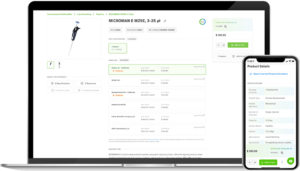What Digital Procurement Means for Life Science Suppliers

Because of declines in R&D efficiency and increased costs to bring drugs to market, there has been an increased focus in assessing procurement strategies and technologies in the move towards digital procurement.
Procurement is receiving increased attention and for good reason. While its formal definition of “finding and acquiring goods or services,” has a long history, it is now seen as a strategic advantage for growing businesses.
As commerce has shifted online - becoming more global, transparent, and competitive - executing an effective procurement strategy is now a make or break proposition. With procurement also moving online, we've seen the rise of enterprise resource planning (ERP) solutions that enable ordering, receiving, invoicing, and payments. As these advance, e-procurement systems are becoming integral to relationship management and data warehousing.
Today, digital procurement focuses on advanced analytics, automation, and data-driven optimization.

The below report excerpt, entitled, "Digital Procurement: The Benefits Go Far Beyond Efficiency," published from Bain helps illustrate procurement's evolution:
"After months of making her case, the chief procurement officer (CPO) of a major multinational walked out of the executive team meeting with a big win—approval for a customized manufacturing process to help speed a new product to market. Her procurement team not only identified the emerging technology, it developed an innovative partnership agreement with two suppliers to codevelop it.
It all began six months earlier, when a business unit leader invited the CPO to brainstorm with his team on how to get a new product to market rapidly. The CPO knew two suppliers, one of which was breaking ground on an innovative production process for rapid prototyping and another using advanced analytics to accelerate design. She proposed codeveloping a customized manufacturing solution with the two suppliers. Procurement would orchestrate an agile team to test the process and, if successful, make the case for investing in the new technique. The business unit leader was thrilled."
In life science, the procurement transition has been slower moving.
Life Science Procurement Finally Goes Digital
In life science, the procurement transition has been slower moving.
Because of declines in R&D efficiency and increased costs to bring drugs to market, there has been an increased focus in assessing procurement strategies and technologies in the move towards digital procurement. The volume of spend has prompted organizations to look more closely at costs and assess new ways to capture savings.
For its part, the industry has moved from physical catalogs, to online web shops, and more recently, ERPs. The larger ERP vendors with their point-to-point integrations have provided a successful backbone, to specific suppliers, for placing orders, tracking, approvals, and maintaining the data critical to running an effective purchase process. But these systems are optimized on retroactively managing the procurement process only to a limited number of suppliers.
As the industry moves towards digital procurement, the emphasis is now on how organizations can get a better holistic understanding of their spend and thinking long-term in order to understand certain trends and have better access to better data.
Also important is how can procurement make the experience more customer-centric. In other words, how do you make the B2B experience more like the B2C experience employees are used to in their everyday lives? Scientists need to focus their valuable time on research, not administrative tasks such as searching for and ordering lab supplies.
The “One-Stop Shop” & Maverick Buying Conundrum
The shift towards digital procurement, has led global distributors to create their own online strategies manifesting in “one-stop shops”, aggregating multiple manufactures into one site. The challenge with this approach is a misalignment with the reality that rapid product innovation has produced tens of millions of SKUs from which research scientists are ordering. “One-stop shops” can not provide all the products these research teams want or need nor can they avoid the implicit bias behind selling their own products versus those from smaller, lesser known suppliers.
However frustrated they are by the fragmented purchasing experience, scientists and researchers refuse to trade a product they need for the organizational efficiency they desire.
As a result, scientists end up “maverick buying”, where they essentially order from any supplier site they want. For procurement and lab managers this creates a significant and time-consuming manual effort. Under this scenario they have limited ability to track where spend is going or what cost center is associated with it, However frustrated they are by the fragmented purchasing experience, scientists and researchers refuse to trade a product they need for the organizational efficiency they desire. "Primed" by the ease of modern marketplaces like Amazon, these buyers hope to find and order all the products they need from one centralized location.
...suppliers need to engage customers online, and provide them the experience they want and expect.
To stay competitive, suppliers need to engage customers online, and provide them the experience they want and expect. Investing in a digital strategy will enable suppliers to maintain control over how their product is being marketed and sold. It will further provide direct visibility and an ongoing relationship with thousands of customers, and help them be more efficient in both growing current customers and reaching new customers at scale.
To learn more about how you can improve your procurement process, book a live demo with one of our lab consultants.
About the Author
 James Pavlovich began his career as a support analyst for Pepsi Bottling Group’s Field Operations group, working on several different programs improving the order fulfillment process. Following Pepsi he held a number of senior consulting roles with PriceWaterhouseCoopers. Nearly 9 years at PwC James further developed his business operations expertise with a particular emphasis on pharma R&D. During this period he managed organizational transformations utilizing innovative technologies to change the way these organizations operate. His previous clients include: large pharma, biotechs, CRO's and FDA. More recently, he joined ZAGENO as its senior director of commercial operations and in July 2019 was named the company's VP of commercial operations.
James Pavlovich began his career as a support analyst for Pepsi Bottling Group’s Field Operations group, working on several different programs improving the order fulfillment process. Following Pepsi he held a number of senior consulting roles with PriceWaterhouseCoopers. Nearly 9 years at PwC James further developed his business operations expertise with a particular emphasis on pharma R&D. During this period he managed organizational transformations utilizing innovative technologies to change the way these organizations operate. His previous clients include: large pharma, biotechs, CRO's and FDA. More recently, he joined ZAGENO as its senior director of commercial operations and in July 2019 was named the company's VP of commercial operations.
James earned his BS in Computer Science from Valparaiso University and his MBA in Management Technology from The University of Connecticut.


